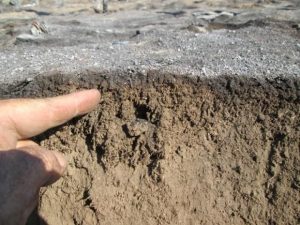Plant health is often top-of-mind for gardeners. We look for clues to determine if our garden inhabitants are healthy or unhealthy and pursue solutions with vigor. Insecticides? Better water management? Too little or too much sun? Fertilizers? We spend a lot of energy pursuing plant health.
But…what about the health of your soil? Soil is often seen as a static entity that is only considered when it is time to fertilize or till. Change is afoot, though, and the soil beneath our feet is increasingly receiving the consideration and respect it deserves as a complex, living entity.
The Natural Resources Conservation Service (NRCS), a federal agency under the United States Department of Agriculture (USDA), has launched an initiative, termed “Soil Health,” aimed at focusing attention on soil as a complex system upon which many processes depend. The word “health” is usually applied only to living systems, and it is appropriately used here. Soil is increasingly recognized as a dynamic system that includes living components (bacteria, fungi, protozoans, nematodes, arthropods, and earthworms) and other organic matter, as well as the commonly-thought-of inert constituents like inorganic soil particles (sand, silt, and clay), minerals, and rock fragments.
The creatures living in the soil are critical to soil health. They help to build that much sought-after “crumbly” structure. Healthy soil structure reduces soil erosion, increases plant water availability and provides nutrients to plants through the process of decomposition, thus helping to protect plants from pests and disease. One teaspoon of rich garden topsoil can hold up to one billion bacteria, several yards of fungal filaments, several thousand protozoa, and dozens of nematodes.
The NRCS recommends four important activities to maintain and improve the health of the soil:
1. Manage More by Disturbing Soil Less. Soil disturbance can result from tillage, leveling, grazing, etc. This often results in bare soil and compaction, which harms soil organisms and can disrupt the delicate balance between fungi, plant roots, and soil microbes. Minimize soil disturbance whenever possible.
2. Diversify Soil Biota with Plant Diversity. A diversity of plant species results in a diversity of soil microbes. Lack of plant diversity results in increased pest and disease problems. It is fun, esthetically pleasing, and beneficial to maintain a variety of native and ornamental plants in our outdoor spaces. For vegetable gardens, diversify through companion planting, crop rotation, and the use of cover crops such as legumes (clover, vetch, beans) and cereals (oats, barley). Cover crops also help to increase soil organic matter and plant-available nitrogen.
3. Grow a Living Root throughout the Year. Plant roots are surrounded by a rhizosphere, a thin zone of increased and concentrated microbial activity (akin to the earth’s atmosphere; very thin, but very essential). This is where a lot of the action takes place in the plant/soil/microbe relationships. Plant roots release food for microbes. Microbes provide nutrients and other compounds to the plant. Nurture and maintain this healthy soil environment by growing long-season crops, or planting cover crops between short-season crops. Improve the food sources for soil microbes by adding organic matter (humus, compost, other plant debris and crop residue).
4. Keep the Soil Covered as Much as Possible. Gardeners can make a positive impact on their soil’s health by maintaining a cover of mulch or other organic matter on the soil surface. This provides a refuge and habitat for beneficial insects and arthropods; conserves soil moisture; keeps the soil cooler in hot summer months; intercepts raindrops during rainy periods (to reduce soil compaction and erosion) and suppresses weed growth. Mulch with straw, leaves, aged wood chips, grass clippings, newspaper and cardboard, evergreen needles, bark, or other natural materials. (There are advantages and disadvantages to each; a little research will help you decide what is best for your situation.)
Learn more about soils and soil health by visiting: https://www.nrcs.usda.gov/wps/portal/nrcs/main/soils/health/.
Cathy Scott is a soil scientist at the Natural Resources Conservation Service.
UCCE Master Gardeners of Tuolumne and Calaveras Counties can answer home gardening questions. Call 209-533-5912 or go to: http://ucanr.edu/survey/survey.cfm?surveynumber=7269 to fill out our easy-to-use problem questionnaire. Check out our website at: http://cecentralsierra.ucanr.edu/Master_Gardeners You can also find us on Facebook.

